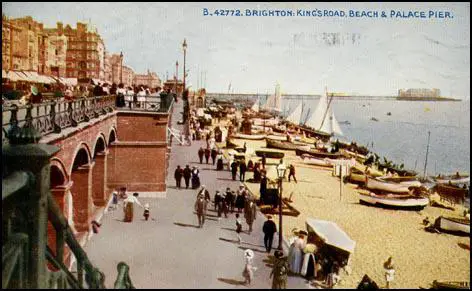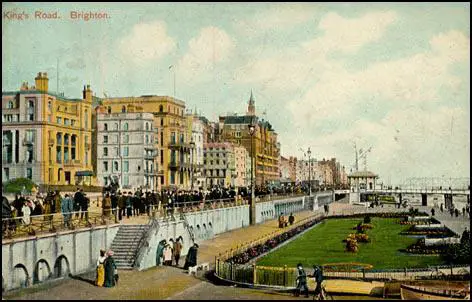Part
6 : The Seaside Holiday Photograph (continued)

1. The Kings Road and the
Beach showing the Lower Esplanade and the the Kings Road Arches.A
postcard dated 1916.
The
Beach, Kings Road Arches and the Lower Esplanade
The
Lower Esplanade ran beneath the Kings Road, from the West
Pier to the Fish Market, below East Street. According to Timothy
Carder, author of 'The Encyclopaedia of Brighton', for many years
the Lower Esplanade was "a ramshackle area frequented
by stall-holders and street entertainers." The Lower
Esplanade followed the shore line and the businesses that operated
here in the 1870s such as boat builders, refreshment rooms and
pleasure boat proprietors, often gave their address simply as
"The Beach."
In
1874, only one photographer, William Dawson, gave his studio
address as The Beach. By 1878, Dawson had been joined at
'The Beach' by Thomas Frederick Foulkes. Dawson's studio
was close to the West Pier, while Foulkes was located some distance
away, near the Middle Street gap.
In
the 1880s, the Kings Road was widened and was bolstered by a row
of arches under the main road. The Kings Road Arches housed
a number of businesses and places of amusement and refreshment.

2 The Kings Road, Brighton
showing the Arches to the west of the West Pier.William Dawson
had his photographic studio, refreshment rooms and other small
businesses on the Lower Esplanade just beyond the West PierA postcard
dated 1906.
Numbering
of the Kings Road Arches was erratic in the 1870s and 1880s, but
generally ran from east to west. In 1888, Joseph Peter Manning
had a photographic room at No 38 Kings Road Arches below Ship
Street; Foulkes's Middle Street gap studio was given the number
46, and Dawson's photographic business was located near the West
Pier, between numbers 65 and 69.
Several
of the photographers listed at Kings Road Arches combined portrait
taking with other business concerns. Wiliam Tickner was
primarily a boat builder, but he also operated as a photographer
from 1887 to 1907. William Dawson owned a photographic
studio in the centre of Brighton at 106 London Road and later
at 128 Richmond Road, but at various times he worked as a seaside
photographer, tobacconist, refreshment room proprietor, a manufacturer
of mineral water and, finally, a fruiterer.
Captain
Fred Collins was famous locally as the owner of the Skylark pleasure
boats and he was also the proprietor of the 'Welcome Brothers'
beerhouse in the Kings Road Arches. His son Frederick Collins
junior assisted his father and took photographs of holidaymakers,
but he also managed the American Bowling Saloon on the Lower Esplanade.
The photographer Lewis Why ran a rifle shooting range at
the eastern end of Kings Road Arches, near the Fish Market, from
1899 right up to 1910. It is assumed that other traders combined
photography with their usual business. Walter Flowers,
originally a carver and gilder, is recorded as the owner of a
bicycle depot and a restaurant in the 1890s, but a photograph
of his refreshment rooms taken around 1900 reveals that he had
a photo studio connected to the tearooms. Walter Flower is not
listed as a photographer and we can take it for granted that other
stall holders and tradesmen also offered a portrait taking service.
The
Numbering of the Kings Road Arches
Around
1890, the Kings Road Arches were re-numbered. The businesses under
the Kings Road were now numbered from left to right, starting
from, rather than ending at William Dawson's premises at No 65.
Dawson's studio address was hardly affected but the reversed ordering
of numbering changed the studio address of J.P.Manning
from No 38 to No 150 Kings Road Arches. Thomas Foulkes,
who had a studio at No 46, was given the number 131. Frederick
Collins junior, who ran a photographic studio at No 54 Kings
Road Arches in 1882, had to change the number to 124 in 1891.
To
confuse matters even further, the numbers on the Arches were changed
again, a couple of years later. Page's 1895 Directory of Professions
and Trades, illustrates that the re-numbering of the Kings Road
Arches aroun 1893 had in effect increased the numbers of each
studio address by a difference of around forty or more. The studio
of Richard Cartwright junior at No 108 became 148 Kings
Road Arches in the 1895 Directory. Frederick Collins junior's
photo rooms which had recently been renumbered 124, was now recorded
as 167 Kings Road Arches. Thomas Foulkes had two separate
studios at 131 and 140 Kings Road Arches in 1892, but Page's Directory
of 1895 lists his studios at 174 and 181, The Arches, Kings Road.
Joseph Peter Mannings' studio number changed from 150 to 193 Kings
Road Arches. Looking at trade directories which span the late
1880s to the early 1900s, it appears that J.P.Manning (like
the other photographers in the Kings Road Arches) was continually
changing the site of his seafront studio, when in fact he was
occupying roughly the same spot over a period of 17 years.The
location of the Kings Road Arches studios remained relatively
constant; it was the numbering of the Arches that was frequently
changing.

3 The
Beach, Brighton. This coloured postcard shows the crowded beach
and, on the left, the traders' stalls and businesses on the Lower
Esplanade. On the left, in front of the Shelter Hall, can be seen
Bolla & Biucchi's Restaurant. Richard Cartwright had a photographic
studio next door to Bolla & Biucchi 's Restaurant from 1890
to 1910 and beyond. Postcard dated 1916.

4
Brighton Front, showing the Kings Road Arches as seen from the
top of the Shelter Hall. Cartwright's studio can be seen with
the blue and white striped awning, immediately to the left of
Bolla & Biucchi's Restaurant. The West Pier is in the distance.

5
The Beach, Brighton. This coloured
postcard shows the Kings Road Arches that stretched along Brighton's
seafront.
CLICK HERE TO CONTINUE
Origins of the Official Post Card